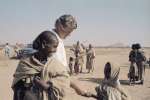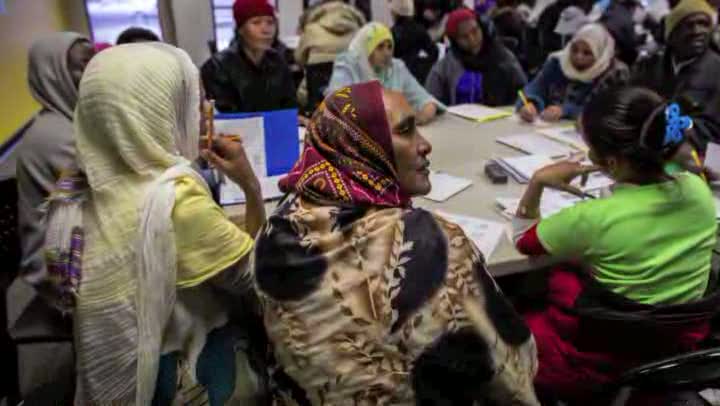Refugees Magazine Issue 148 (Refugee or Migrant?) - Mexico: The Great Migration to the North
Refugees Magazine, 1 December 2007
The route via Mexico to the US is fraught with risk for refugees and migrants alike.
By Mariana Echandi, Marion Hoffmann and Rupert Colville
It is estimated that half a million undocumented migrants cross Mexico's southern border every year, most of them Central Americans attempting to move on to the United States or, to a lesser extent, Canada. According to figures from Mexico's National Migration Institute, in the first nine months of 2007, some 45,000 undocumented migrants had been detained at migration holding centres across the country. However, many migrants appear to succeed in crossing Mexico undetected, and the US Border Patrol often ends up apprehending more than 1,000 a day.
Stricter migration controls by both Mexico and the United States, as well as a string of natural disasters affecting southern Mexico and Central American States, have had a strong impact on the migration routes. Since the destruction of 300 kilometres of railway by Hurricane Stan in 2005, most migrants have had to walk hundreds of kilometres across the borders of El Salvador, Honduras and Guatemala to reach the city of Arriaga in Mexico's Chiapas Province, where they climb on cargo trains heading north.
At the southern border itself, there appear to be at least three main land routes into Mexico, via the Guatemalan cities of El Naranjo, la Mesilla or Tecún Uman. Some migrants are also now using boats from Guatemala's Pacific sea ports to avoid migration checkpoints on the land borders.
Although most of the migrants are men, there are also many women and children travelling along these dangerous routes, which cost hundreds – if not thousands – of lives a year.
At the US border alone, at least 400 people died during the year up to 30 September 2007, many of them from thirst, heat or exhaustion in the Arizona desert. Others died in vehicle and train accidents, or drowned in the great river (known to Americans as the Rio Grande and to Mexicans as the Rio Bravo) which extends for more than half the length of the 3,200 kilometre border.
Women at risk
Many more probably die, or are syphoned off by criminal gangs, long before they get anywhere near the United States, with women particularly vulnerable to being sexually abused or forced into long-term prostitution. Indeed, one Mexican Senator, Maria Elena Orantes, has suggested that up to 80 percent of women migrants heading up from the south end up involved in the sex trade in some way or other, with tens of thousands forced into prostitution each year along the Guatemala-Mexico border area alone.
Nobody questions the fact that the great majority of the people heading up to North America in this way are doing so for economic reasons, and there is no end of debate about whether this is, on balance, a good or bad thing for the economies of their home countries, of Mexico and of the US. But there are always some among them – if not today, then yesterday or tomorrow – who are refugees. And when the percentage is small, they are often less easy to identify.
The number of asylum applications made in Mexico is minuscule compared to the number of people passing through – perhaps one in a thousand, although some of the others will later claim asylum in the US.
In 2003, UNHCR established a small office in Tapachula, a city close to the Guatemalan border in the state of Chiapas. Since then, a total of some 600 people have filed asylum applications to the Mexican authorities there. From January to October 2007, 154 individuals applied for asylum in Tapachula, of whom 12 percent were Somalis, 11 percent Bangladeshis, 10 percent Eritreans, and 8 percent Colombians and Ethiopians.
From a far continent
Some of the non-Latin American asylum seekers end up in Mexico for bizarre reasons. One 31-year-old Sri Lankan, for example, claims he fled after escaping from the Tamil Tigers. After hitching a lift on a fishing boat to the Maldives, he stowed away on a bigger ship. "I was hidden in the machinery room of a tourist boat thinking that I was heading to Europe," he told UNHCR officials in Mexico, "and when I got off the ship, they told me I was in Guatemala."
From there, he joined the thousands of undocumented Central American migrants travelling north, until he reached Tapachula, where he was advised by a NGO working with UNHCR to apply for asylum with the Mexican authorities.
Another asylum seeker, a 26-year-old man from Darfur in Sudan, came by an equally haphazard route. "First I went to Ethiopia, then to Somalia and then to Egypt, where I took a boat that went to Panama," he said. "Once in Panama, I met some Africans there who told me that if I wanted to apply for asylum, I should go to Mexico."
Unlike many of his fellow travellers, he says he is happy to stop in Mexico, where he is trying (with difficulty) to get a job as an English teacher. "They kept me in custody at the immigration detention centre where I met other Sudanese, and Eritrean and Ethiopians," he recalls. "They told me that they were going to the US."
Rampant gangs
One of the most intriguing phenomena in the region involves people escaping from the so-called 'maras,' the extremely violent street gangs that are present in force throughout Central America and also in southern Mexico. The maras (the word is derived from the name of an especially fierce carnivorous ant species) include children as young as ten.
Most of the asylum claims presented by Hondurans, Salvadorans and Guatemalans to the Mexican asylum authorities are by youngsters or families alleging persecution by these gangs. Some fear forcible recruitment by the maras. Others are petrified of revenge because they have witnessed their crimes.
In 2007, the Mexican National Migration Institute issued internal regulations (drawn up with assistance from UNHCR) to facilitate the granting of humanitarian status to those asylum seekers who are found not to qualify for refugee status under the 1951 Refugee Convention or the key regional refugee instrument known as the Cartagena Declaration, but who may clearly be in need of another form of protection. And UNHCR, UNICEF and other agencies have been attempting to set up a system to help the exceptionally vulnerable unaccompanied children stranded in this febrile border zone.
Meanwhile the great migration north continues, full of largely unseen tragedies and heartbreak as people, for one reason or another, fall by the wayside.





















